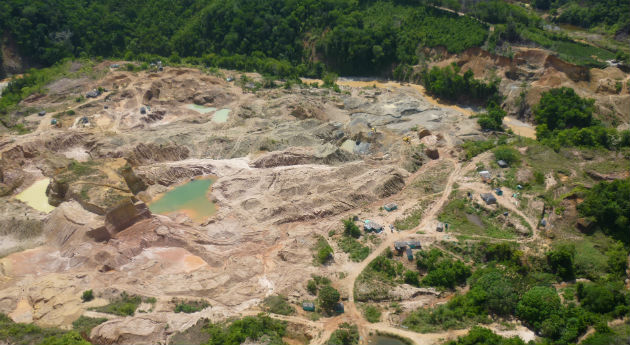Illegal mining in Colombia is a growing threat


According to the Colombian Mining Dialogue Group (GDIAM) illegal mining is “any mining that lacks the necessary mining permission or doesn’t have the authorization of the land’s owner. It also lacks at least one of the paperwork demanded by the law like the environmental license or the payments for benefitting form a natural resource.”
“[This] mining in Colombia is the worst threat for its ecosystems, water, biodiversity, and people’s health,” told Mongabay, Julia Miranda, Director from Colombian National Parks. Even if the police and national army have succeeded in stopping some of this activity, it is still growing at an alarming pace, added Mrs. Miranda.
One of the reasons why illegal mining has grown is the peace treaty with las FARC guerrilla, told Mongabay Carlos Alberto Botero, Environmental vice minister. “Now that these groups aren’t there, people can reach these sites more easily and they know they have lesser risks.”
The Ministry is currently working in new legislation that allows them to cope with illegal mining in this new era for the country.
“With the peace treaty and FARC leaving their weapons it is necessary for Colombia to build up a stronger management of the land and have more institutions involved in both the national and regional levels to reduce the economic and social’s gap and avoid the further degradation of the environment,” added Ximena Barrera, WWF Colombia Politic Director.
But how does it affect the environment?
Illegal mining causes deforestation. According to a study done by Sergio Arboleda University, between 1990 and 2010 at least 310,349 hectares of forest were cut every year. This represents more than 5,4% of the national territory.
Also, it pollutes waters with mercury and cyanide which are used when mining for gold. According a report by the Environment Ministry and the Colombian Hydrology, Meteorology and Environmental Studies Institute (IDEAM) at least 200 tons of mercury are thrown IGNORE INTO the rivers, especially in the Nariño, Chocó and Antioquia departments. This is toxic both for humans and animals who drink it and also degrades the land.
Species are also affected by this activity, for example, in the Caquetá River illegal mining affects the nesting of the Charapa Turtle (Podocnemis expansa) as the beach is completely destroyed and they have nowhere safe to leave their eggs.
Another concerning fact is that in the Chocó department is Colombia’s gold producer, even though most of the exploited land has no legal permit. Between 2012 and 2013 the number of dredges increased by 180% causing the degradation of more than 64,000 hectares of land, added Barrera. WWF Colombia is currently promoting development projects that have an sustainable focus for the region and its people.
More so, illegal mining causes social conflicts. According to the Global Environmental Justice Atlas, created by the Institute of Environmental Science and Technology (ICTA) at the Universitat Autonoma de Barcelona, Colombia is one of the countries with the most socio-environmental conflicts in the world and illegal mining causes most of them.
The conflicts related to illegal mining “are related with the land management. There’s a lack of communication and sense between the planning, the local government plans and the delivery of permits and environmental licenses,” added Barrera.
LatinAmerican Post | Maria Andrea Marquez





